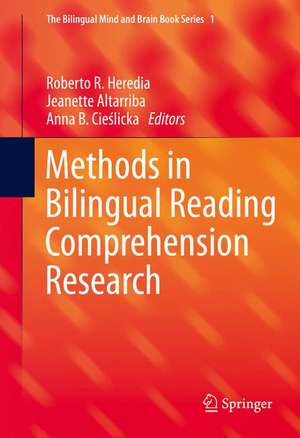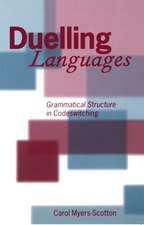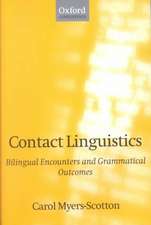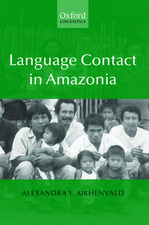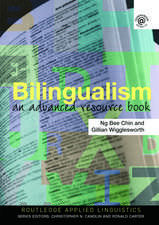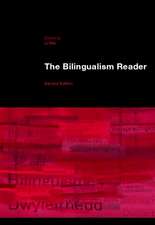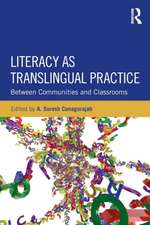Methods in Bilingual Reading Comprehension Research: The Bilingual Mind and Brain Book Series, cartea 1
Editat de Roberto R. Heredia, Jeanette Altarriba, Anna B. Cieślickaen Limba Engleză Hardback – 17 oct 2015
| Toate formatele și edițiile | Preț | Express |
|---|---|---|
| Paperback (1) | 394.29 lei 43-57 zile | |
| Springer – 23 aug 2016 | 394.29 lei 43-57 zile | |
| Hardback (1) | 401.79 lei 43-57 zile | |
| Springer – 17 oct 2015 | 401.79 lei 43-57 zile |
Preț: 401.79 lei
Nou
Puncte Express: 603
Preț estimativ în valută:
76.88€ • 80.49$ • 63.62£
76.88€ • 80.49$ • 63.62£
Carte tipărită la comandă
Livrare economică 07-21 aprilie
Preluare comenzi: 021 569.72.76
Specificații
ISBN-13: 9781493929924
ISBN-10: 1493929925
Pagini: 275
Ilustrații: XVIII, 383 p. 40 illus., 24 illus. in color.
Dimensiuni: 155 x 235 x 30 mm
Greutate: 0.74 kg
Ediția:1st ed. 2016
Editura: Springer
Colecția Springer
Seria The Bilingual Mind and Brain Book Series
Locul publicării:New York, NY, United States
ISBN-10: 1493929925
Pagini: 275
Ilustrații: XVIII, 383 p. 40 illus., 24 illus. in color.
Dimensiuni: 155 x 235 x 30 mm
Greutate: 0.74 kg
Ediția:1st ed. 2016
Editura: Springer
Colecția Springer
Seria The Bilingual Mind and Brain Book Series
Locul publicării:New York, NY, United States
Public țintă
GraduateCuprins
Preface: Marcel A. Just Patricia A. Carpenter Chapter 1: Reading paradigms and bilingual language processing: Empiricism and theory (Jeanette Altarriba, SUNY-Albany; Anna B. Cieślicka, Texas A&M International University [TAMIU]; Roberto R. Heredia, TAMIU). Chapter 2 Context effects in bilingual sentence processing: Task specificity (Debra Jared, University of Western Ontario, Canada). Chapter 3: Off-line versus on-line psycholinguistic techniques: Which is which? (Tracy Love, San Diego State University) Chapter 4: Rapid Serial Visual Presentation (RSVP): What is so rapid about RSVP? (Jeanette Altarriba, SUNY-Albany) Chapter 5: The reading visual moving window. (Roberto R. Heredia, TAMIU) Chapter 6: Priming and on-line multiple language activation. (Anna. B. Cieślicka, TAMIU) Chapter 7: The Maze: A reading integration task. (Ken Forster, University of Arizona) Chapter 8: Eye-movements and bilingual reading comprehension. (Debra Titone, McGill University, Canada) Chapter 9: Connectionist models and bilingual reading comprehension. (Jonathan Grainger, Université d'Aix-Marseille, France) Chapter 10: Behavioral vs. neurological psycholinguistic techniques: Different DV same ask. (Jyotsna Vaid, Texas A&M University) Chapter 11: Event Related Potentials (ERPs) and bilingual reading (Eva M. Moreno, Universidad Complutense de Madrid, Spain). Chapter 12: fMRI and bilingual sentence comprehension (Kerrie E. Elston-Gütter, Max Planck Institute for Human Cognitive andBrain Sciences, Germany)
Notă biografică
Roberto R. Heredia is a professor of psychology at Texas A&M International University (TAMIU); his research interests include Lexical access, bilingual lexical processes, lexical ambiguity, figurative language processes, sentence processing, second-language acquisition, word recognition, memory and information processing. He is a former Chair of the Behavioral Sciences department at TAMIU. He is a Series Coeditor for The Bilingual Mind and Brain Book Series, published by Springer.
Jeanette Altarriba is a professor of psychology at State University of New York, (SUNY) Albany as well as the Director of the Cognition and Language Laboratory at SUNY-Albany. Her research interests include psychology of language, psycholinguistics, second language acquisition, bilingualism, knowledge representation, eye movements and reading, concept and category formation and cognition and emotion.
Anna B. Cieślicka is an assistant professor of psychology at Texas A&M International University (TAMIU); her research focuses on the psycholinguistics of second language acquisition. She is a Series Coeditor for The Bilingual Mind and Brain Book Series, published by Springer.
Jeanette Altarriba is a professor of psychology at State University of New York, (SUNY) Albany as well as the Director of the Cognition and Language Laboratory at SUNY-Albany. Her research interests include psychology of language, psycholinguistics, second language acquisition, bilingualism, knowledge representation, eye movements and reading, concept and category formation and cognition and emotion.
Anna B. Cieślicka is an assistant professor of psychology at Texas A&M International University (TAMIU); her research focuses on the psycholinguistics of second language acquisition. She is a Series Coeditor for The Bilingual Mind and Brain Book Series, published by Springer.
Textul de pe ultima copertă
The collected chapters in this volume present an overview and state-of-the-field of traditional and recently developed methodological approaches to the study of bilingual reading comprehension. It critically reviews and examines major findings from classical behavioral approaches such as the visual moving window, rapid-serial visual presentation (RSVP), and eye-tracking, as well as newly developing neuropsycholinguistic methodologies such as Event-Related Potentials (ERPs), and Functional Magnetic Resonance Imaging (fMRI). Written to address a timely topic, Methods in Bilingual Reading Comprehension Research updates the field of bilingual reading by critically examining the contributions of the various behavioral and technologically-based reading techniques used to understand psychological processes underlying written language comprehension. Each topic is covered first from a theoretical, and then from an experimental, viewpoint. Moreover, the volume contributes to the development and establishment of Bilingual Reading as a subfield of bilingual sentence processing and fills a significant gap in the literature on bilingual language processing and thought.
Significantly, Methods in Bilingual Reading Comprehension Research presents an overall view of some of the typical psycholinguistic techniques and approaches, as well as proposing other possible tasks that may prove viable in investigating such theoretical issues as bilingual lexical ambiguity resolution, or how bilingual speakers might resolve multiple sources of potentially conflicting information as they comprehend sentences and discourse during the communicative process. In addition, to aid reader comprehension and encourage readers to acquire “hands on” experience in the creation and development of experiments in the realm of bilingual reading research, each chapter includes a list of key words, suggested student research projects, and questions to
both help the reader review the chapter and expand upon the reading. With its comprehensive coverage of a crucial subfield of psycholinguistics and language processing, Methods in Bilingual Reading Comprehension Research is an invaluable and informative resource for all students and researchers in bilingualism, neurolinguistics, bilingual cognition, and other related fields.
Significantly, Methods in Bilingual Reading Comprehension Research presents an overall view of some of the typical psycholinguistic techniques and approaches, as well as proposing other possible tasks that may prove viable in investigating such theoretical issues as bilingual lexical ambiguity resolution, or how bilingual speakers might resolve multiple sources of potentially conflicting information as they comprehend sentences and discourse during the communicative process. In addition, to aid reader comprehension and encourage readers to acquire “hands on” experience in the creation and development of experiments in the realm of bilingual reading research, each chapter includes a list of key words, suggested student research projects, and questions to
both help the reader review the chapter and expand upon the reading. With its comprehensive coverage of a crucial subfield of psycholinguistics and language processing, Methods in Bilingual Reading Comprehension Research is an invaluable and informative resource for all students and researchers in bilingualism, neurolinguistics, bilingual cognition, and other related fields.
Caracteristici
Presents a comprehensive overview of the various psycholinguistic and neurophysiological tasks used to measure bilingual language processing Combines major findings from classical behavioral cognitive methodologies and newly developing neuropsycholinguistics methodologies such as fMRI Includes review questions and suggested student research projects at the conclusion of each chapter to enhance student comprehension Includes supplementary material: sn.pub/extras
